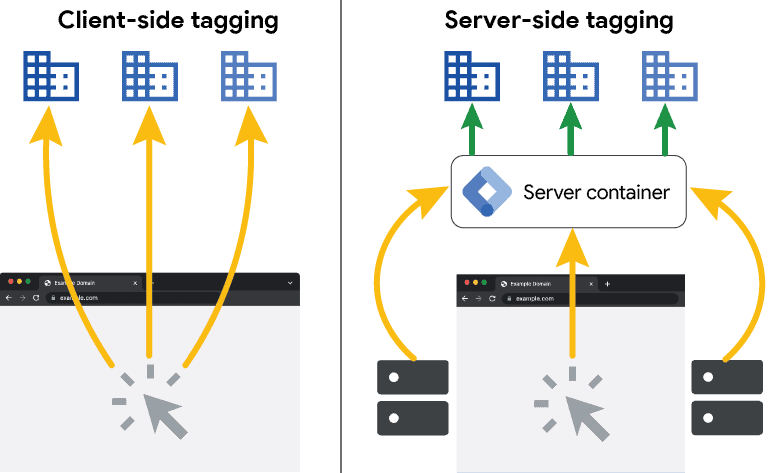Server Side Tracking
Increase Conversion & Accuracy
Server side tracking offers several key benefits for businesses looking to monitor and analyze their online activity. By shifting tracking processes to the server side, companies can reduce issues related to ad blockers, increase data accuracy, and enhance user privacy.
Additionally, server side tracking can improve website loading speeds and provide a more complete view of user behavior across different devices. With data securely stored on the server, businesses can make more informed decisions based on reliable information, leading to better-targeted marketing campaigns and improved overall performance.
Some of the most popular integrations are:
- Facebook / Meta
- Tiktok
- Snap
- Google Ads

When considering or implementing server-side tracking, there are several typical questions that often arise. Here are some of the most common questions and their answers:
What is server-side tracking, and how does it differ from client-side tracking?
Server-side tracking collects and processes data on the server rather than in the user’s browser. This contrasts with client-side tracking, where JavaScript running in the browser sends data directly to analytics and marketing platforms. Server-side tracking involves sending data from the browser to the server, which processes and forwards it to third-party services.
What are the benefits of server-side tracking?
- Enhanced Data Control and Privacy: Greater control over data shared with third parties, easier compliance with privacy regulations.
- Improved Website Performance: Faster page loads and reduced browser load due to less JavaScript running on the client side.
- Better Data Quality and Consistency: Reduced data loss from ad blockers and browser restrictions, more reliable data collection.
- Advanced Tracking Capabilities: Simplifies cross-domain tracking and allows for more sophisticated attribution modeling.
What are the challenges of implementing server-side tracking?
- Technical Expertise: Requires a higher level of technical knowledge and skills for setup and maintenance. Thankfully if you choose to work with us, this wont be a problem.
- Increased Costs: Higher expenses for initial setup, ongoing maintenance, and potential vendor charges.
- Complex Infrastructure: Need for additional server resources and infrastructure management.
How does server-side tracking impact data privacy and compliance?
Server-side tracking enhances data privacy by allowing you to control and anonymize data before sharing it with third-party services. This makes it easier to comply with data privacy regulations like GDPR and CCPA, as you can ensure that sensitive information is handled appropriately.
What technical skills are needed for server-side tracking?
Implementing server-side tracking requires knowledge of server management, web development, and familiarity with relevant programming languages (e.g., JavaScript, Python, Node.js). Additionally, understanding how to set up and manage APIs and data processing workflows is crucial.
Can server-side tracking work with existing analytics and marketing tools?
Yes, server-side tracking can be integrated with most analytics and marketing tools. However, it may require additional customization and configuration to ensure compatibility. Some tools offer specific support for server-side tracking, while others might need workarounds or custom implementations.
Does server-side tracking affect website performance?
Server-side tracking generally improves website performance by reducing the amount of JavaScript running in the user’s browser, leading to faster page load times and a better user experience. However, the server-side processing itself must be optimized to avoid any significant delays.
What are the cost implications of server-side tracking?
Costs can increase due to the need for additional server infrastructure, technical expertise for setup and maintenance, and potential vendor charges for server-side tracking capabilities. It’s important to evaluate these costs against the benefits of enhanced data control, privacy, and performance improvements.
How do I decide if server-side tracking is right for my organization?
Consider your organization’s priorities regarding data privacy, accuracy, and website performance. Assess your technical capabilities and budget for managing the implementation and ongoing maintenance. If your organization values precise data control and is prepared for the additional complexity and costs, server-side tracking could be a valuable investment.
Are there any tools or platforms that simplify server-side tracking?
Several platforms and tools provide solutions for server-side tracking, such as Google Tag Manager Server-Side, Segment, and Tealium. These tools can help streamline the implementation process and offer features to manage and monitor your tracking setup.
